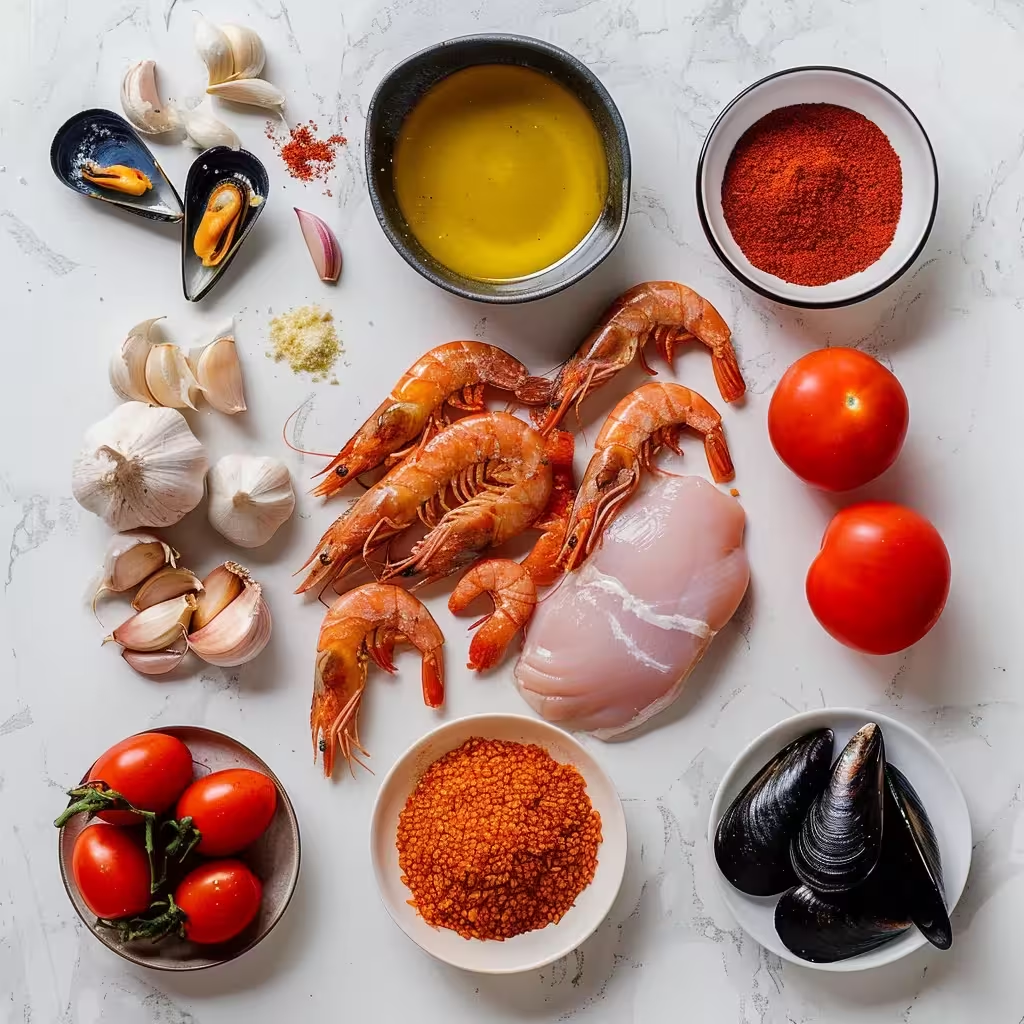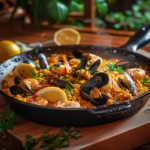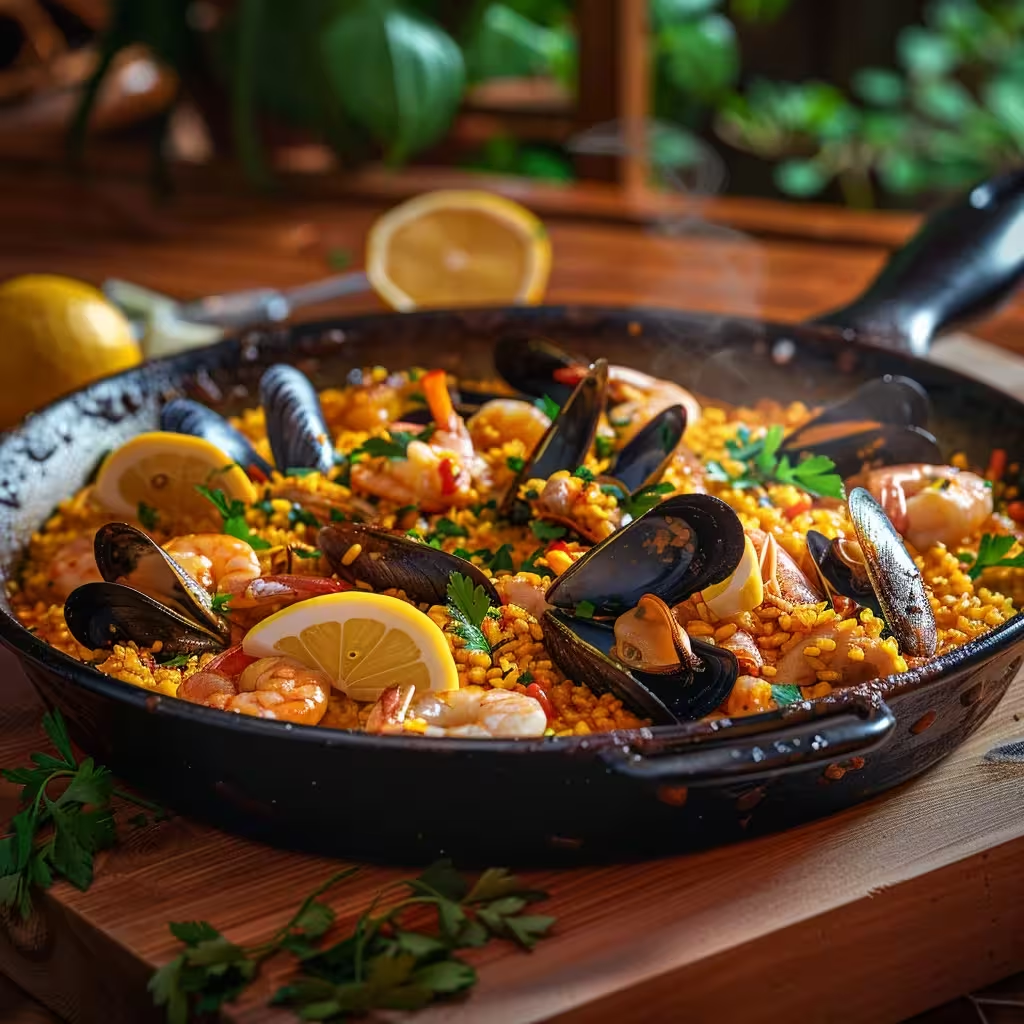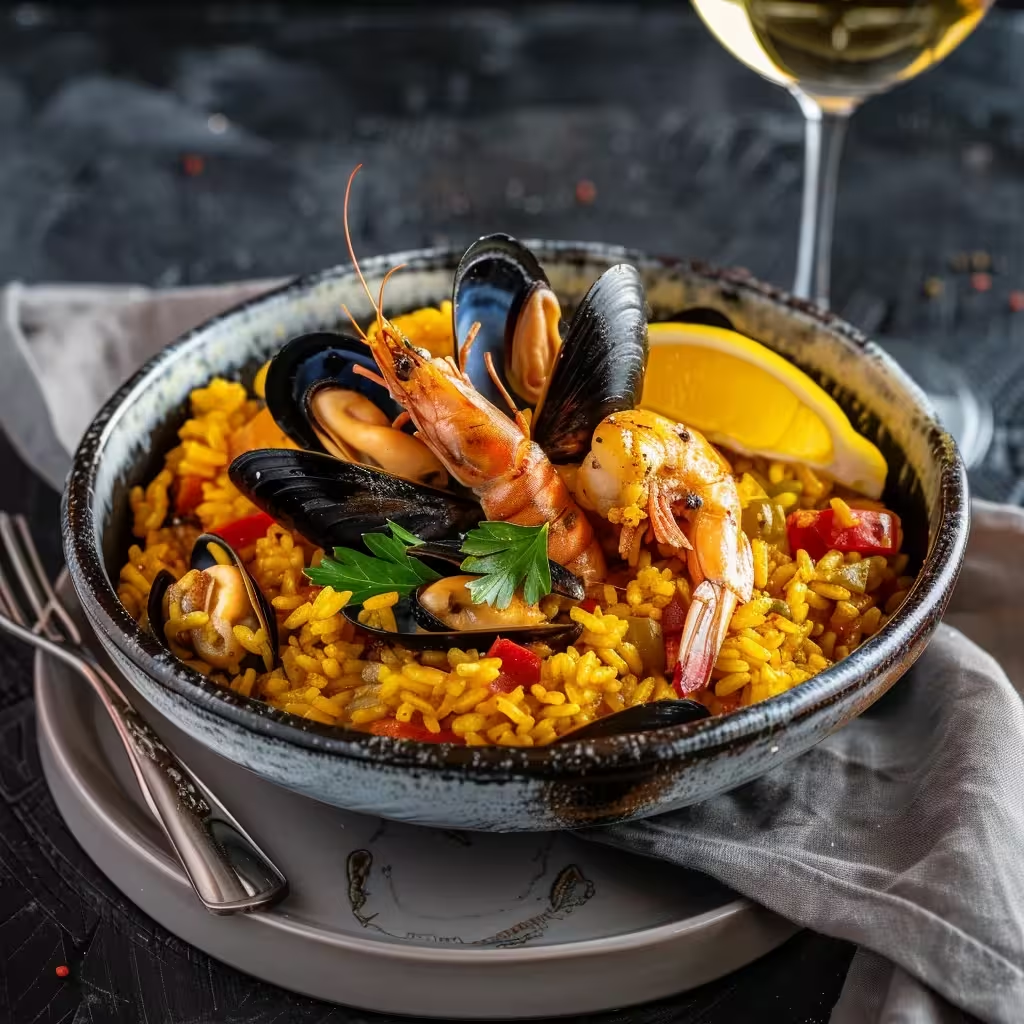If there’s one dish that captures the warmth, tradition, and soul of Spanish cooking, it’s Spanish paella. With its golden saffron rice, tender seafood or meats, and deep layers of flavor, paella is more than just a meal — it’s a celebration in a pan. In this guide, I’ll walk you through what makes Spanish paella truly authentic, how to make it at home, the secret ingredients pros use, and how to recreate that signature taste. Whether you’re new to paella or looking to perfect your technique, you’re about to learn why it’s one of Spain’s most iconic dishes.
A Family Tradition — My First Taste of Real Spanish Paella
From vacation to obsession: how paella stole my heart
The first time I tasted real Spanish paella, I was sitting at a tiny coastal café in Valencia, the dish’s spiritual home. The table was shaded by orange trees, the air thick with sea breeze and garlic, and the pan — wide, rustic, and sizzling — was brought out like a crown jewel. I still remember how the saffron-scented rice glistened under a layer of fresh clams, shrimp, and roasted peppers. One bite, and I was hooked. It was bold, comforting, slightly smoky, and brimming with flavor in a way I had never experienced before.
Back home, I couldn’t stop thinking about it. I researched paella pans, called Spanish groceries to track down real bomba rice, and tested batch after batch until the kitchen smelled like a Mediterranean market. That’s when I truly fell in love with this dish — not just for the flavor, but for what it represents: a shared table, a family gathering, a slow-cooked moment of joy.
These days, Spanish paella has become a signature dish in my home, one I turn to when I want to bring people together or transport myself back to that sunny afternoon in Valencia. And now, I’m sharing it with you.
Why Spanish paella is more than just rice and seafood
Paella isn’t just a recipe — it’s a tradition, a ritual, a regional treasure. While most people picture seafood paella, the dish actually originated in the countryside of Valencia with rabbit, chicken, and green beans. Over time, it evolved across Spain into countless variations: mariscos (seafood), mixta (mixed), and even vegetarian options, each one rooted in local culture and seasonal ingredients.
At its core, Spanish paella is about balance — between the smoky, golden rice and the juicy protein toppings, between the earthy sofrito and the sun-bright saffron. You’ll find other dishes with that same soul-warming appeal in my comfort food and family meals categories, but paella stands in a league of its own.
Whether cooked over an open flame or on a stovetop, paella invites you to slow down, share, and savor. And that’s exactly what we’re going to do.
Essential Ingredients for Traditional Spanish Paella

What’s in a real Spanish paella?
So what exactly goes into an authentic Spanish paella? While recipes vary across regions, most classic versions include a few key ingredients that give this dish its iconic flavor and texture. The heart of paella is bomba rice — a short-grain variety grown in Spain that absorbs liquid beautifully without turning mushy. It’s essential for achieving the dish’s signature tender bite.
Next comes sofrito — a slow-cooked blend of onions, garlic, tomatoes, and olive oil that forms the base layer of flavor. Add to that rich chicken broth, saffron threads, and smoked paprika (pimentón), and you’ve got the soul of the dish. From there, paella branches off. A traditional Valencian paella uses chicken, rabbit, and green beans. A seafood paella includes shrimp, mussels, clams, and sometimes squid or fish.
For those aiming to recreate restaurant-level results at home, understanding the ingredient order is key — rice is never stirred once the broth is added, ensuring the crispy layer known as socarrat forms underneath.
Want more than just the basics? Visit this expert Serious Eats guide to paella rice for a deep dive into the different Spanish rice varieties — it’s a must-read for any home cook looking to master the art.
Print
Spanish Paella: Authentic Ingredients, Flavor Secrets & Recipe Guide
- Total Time: 55 minutes
- Yield: 4 servings 1x
Description
A classic Spanish paella recipe made with saffron rice, chicken, shrimp, mussels, and vegetables. Rich in flavor and tradition, this dish is perfect for gatherings and showcases the soul of Spanish cuisine.
Ingredients
2 tbsp extra virgin olive oil
1/2 lb chicken thighs, bone-in and skin-on
1/2 lb raw shrimp, peeled and deveined
1/2 lb mussels or clams, cleaned
1 1/2 cups bomba or short-grain paella rice
1/4 tsp saffron threads
1 tsp smoked paprika (pimentón)
1 medium onion, finely chopped
2 cloves garlic, minced
1 ripe tomato, grated or finely chopped
1/2 cup green beans (optional)
4 cups chicken broth, warm
Salt and pepper to taste
Lemon wedges and chopped parsley for garnish
Instructions
1. In a paella pan or wide skillet, heat olive oil over medium heat. Sear chicken pieces until golden on both sides. Remove and set aside.
2. Add shrimp and cook for 1–2 minutes until lightly pink. Remove and set aside.
3. Sauté onion and garlic in the same pan until soft. Add grated tomato and cook down into a sofrito.
4. Stir in smoked paprika and saffron. Let bloom for 30 seconds.
5. Add the rice and toast for 1 minute in the pan to absorb the flavors.
6. Pour in warm chicken broth. Gently distribute rice. Do not stir after this point.
7. Arrange chicken, shrimp, and mussels on top. Add green beans if using.
8. Simmer uncovered for 18–20 minutes until rice is cooked and liquid is absorbed. Increase heat in last 2–3 minutes to form the crispy socarrat.
9. Turn off heat. Cover with a towel and rest for 5 minutes. Garnish with lemon wedges and parsley before serving.
Notes
Use a paella pan if available — the wide surface helps achieve even cooking and socarrat.
Saffron is essential for traditional flavor; do not substitute with turmeric.
Make it vegetarian by omitting seafood and meat and using vegetable broth and artichokes.
- Prep Time: 20 minutes
- Cook Time: 35 minutes
- Category: Rice
- Method: Stovetop
- Cuisine: Spanish
Nutrition
- Serving Size: 1 generous portion
- Calories: 570
- Sugar: 3g
- Sodium: 820mg
- Fat: 22g
- Saturated Fat: 5g
- Unsaturated Fat: 15g
- Trans Fat: 0g
- Carbohydrates: 53g
- Fiber: 3g
- Protein: 36g
- Cholesterol: 155mg
Keywords: Spanish paella, traditional paella, seafood paella, saffron rice, paella recipe
Spanish pantry: what makes it authentic?
The difference between a decent rice dish and a true Spanish paella comes down to the pantry. First, real saffron is non-negotiable — no substitutes. While turmeric may provide color, it lacks the floral, earthy aroma saffron brings. Look for quality Spanish saffron in threads, not powder.
Another must-have is pimentón de la Vera — a sweet smoked paprika that gives the dish depth and a hint of smokiness. You’ll also want extra virgin olive oil, flat-leaf parsley, and either shell-on seafood or skin-on bone-in chicken to build layers of flavor.
You can explore more essential ingredients like these in my kitchen tips section, where I break down pantry staples for Mediterranean and comfort food cooking.
From the right rice to the perfect olive oil, choosing authentic ingredients will elevate your paella and bring the soul of Spain right into your kitchen.
How to Make Spanish Paella at Home
Building the layers: sofrito, broth, and socarrat
Making Spanish paella from scratch may seem intimidating, but once you understand the order of operations, it becomes a rhythmic, joyful process. First, you’ll want to build flavor from the bottom up. Start by searing your proteins — whether that’s chicken, rabbit, or seafood — in a wide, shallow pan with olive oil. Remove them once browned to avoid overcooking later.
Next, create your sofrito. Slowly cook chopped onion, garlic, and tomato in the same pan. This step takes patience — the longer you let it reduce, the more intense and sweet the base becomes. Once the sofrito is thick and rich, return your protein to the pan and stir in bomba rice, making sure it’s well coated.
Then comes the broth — infused with saffron and pimentón — poured gently over the rice. The golden rule here? Do not stir once the broth is added. Stirring disrupts the rice’s ability to cook evenly and prevents the prized socarrat — that crispy, caramelized bottom layer — from forming.
For a deeper dive into socarrat, read this Spain on a Fork guide that breaks down how to master it without burning your rice. It’s a crucial step in achieving restaurant-quality Spanish paella at home.
Secret ingredient in Spanish paella?
When people ask what the secret ingredient in Spanish paella is, they’re often expecting something exotic. But the truth is more subtle — it’s not just saffron or smoked paprika, though both are vital. The real secret is layered flavor and technique.
The magic of paella lies in the ritual: slowly toasting the rice in sofrito, using homemade broth or stock (not just water), and never rushing the simmer. Some chefs even add a dash of sherry vinegar or lemon zest at the end to brighten the dish — it’s that final flourish that makes everything sing.
And of course, no matter how fancy or rustic your version, cooking with care and confidence is the real secret. In fact, I share similar step-by-step flavor-building techniques in my quick & easy section, for cooks who want delicious results without overcomplication.
Taste, Serving, and

Storage
What does Spanish paella taste like?
Describing the taste of Spanish paella is like trying to explain a sunset — layered, bold, and unforgettable. At first bite, you’re greeted by the warmth of saffron-infused rice — floral, earthy, and rich. That blends with the savory sweetness of slow-cooked sofrito, while smoked paprika adds just a hint of depth and fire. Depending on your ingredients, you may get a briny hit from shrimp or mussels, or a juicy burst of roasted chicken or chorizo.
The rice itself — tender but never mushy — carries all these flavors, soaking in broth, olive oil, and seasoning like a sponge. And then there’s the socarrat: the golden, crispy bottom layer that’s slightly toasted, caramelized, and utterly addictive. That texture contrast is what gives Spanish paella its soul.
Each bite is a balance of umami, herbs, sea salt, and citrus, especially if served the traditional way with a lemon wedge on the side. You can explore more dishes with this deep, satisfying flavor profile in my dinner recipes — especially those that rely on layering and slow simmering.
Serving traditions & leftovers
In Spain, paella is served right in the pan, placed at the center of the table. It’s a social dish, meant to be shared — no cheese, no cream, and absolutely no stirring after it hits the table. Lemon wedges are customary, and so is a glass of crisp white wine or a light red like Tempranillo.
If you have leftovers, store them in an airtight container and refrigerate for up to 3 days. To reheat, warm gently in a nonstick skillet to revive the socarrat. Avoid microwaving if possible — it softens the texture and flattens the flavors.
You can also repurpose leftovers into croquettes, rice-stuffed peppers, or quick grain bowls. I share more of these storage-friendly dishes and creative reuse ideas in my meal planning category, which is full of clever ways to stretch homemade meals into multiple servings.
Frequently Asked Questions About Spanish Paella
What is in a typical Spanish paella?
A traditional Spanish paella includes short-grain rice (usually bomba), saffron, olive oil, and a base of sofrito made from tomatoes, garlic, and onions. Depending on the region, it may contain seafood like shrimp and mussels, or land proteins like chicken, rabbit, or chorizo. Paella Valenciana is the most classic version, often combining rabbit, green beans, and snails.
What are the 10 essential ingredients for paella?
The 10 must-haves for authentic Spanish paella are: bomba rice, saffron, extra virgin olive oil, garlic, onions, tomatoes, smoked paprika, chicken or seafood, chicken broth, and green beans (for Valencian-style). These build the layered flavor paella is known for.
What is the secret ingredient in paella?
While saffron is the most recognized signature spice in Spanish paella, the real secret lies in the technique — especially building flavor through sofrito and creating socarrat, the crispy rice layer. Some chefs also add a splash of sherry vinegar or lemon zest at the end to enhance flavor.
What does Spanish paella taste like?
Spanish paella has a rich, savory flavor with notes of saffron, roasted garlic, slow-cooked tomato, and the deep umami of broth and protein. Seafood paella carries briny depth, while mixed or chicken versions are earthy and smoky. The socarrat adds a nutty crunch that ties it all together.
Conclusion: Paella Isn’t Just a Dish — It’s an Experience
At its heart, Spanish paella is more than just rice and saffron — it’s a story told through flavor, tradition, and togetherness. It invites you to slow down, savor every bite, and celebrate life around the table. Whether you’re recreating memories of travel or building new ones at home, paella offers comfort, connection, and culinary joy with every golden bite.

